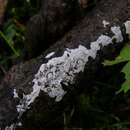ar
الأسماء في صفحات التنقل


Ceriporia is a widely distributed genus of crust fungi.
The genus was circumscribed by Dutch mycologist Marinus Anton Donk in 1930, with Ceriporia viridans as the type species.[2] The generic name combines the Latin word cera ("wax") and the name Poria.[3]
Molecular phylogenetic analyses have shown that Ceriporia is not monophyletic,[4][5] despite an earlier study which suggested the contrary.[6] The presence or absence of cystidia is not considered a phylogenetic character in delimiting the species of Ceriporia.[4]
Although traditionally classified in the family Phanerochaetaceae,[7] recent molecular phylogenetic analysis supports the placement of Ceriporia in the Irpicaceae.[8][9][10]
A 2008 estimate placed 22 species in the genus.[7] As of September 2016, Index Fungorum accepts 49 species of Ceriporia.[11] Twenty species occur in China;[4] eighteen species are found in the neotropics.[12]
{{cite journal}}: Cite journal requires |journal= (help) Ceriporia is a widely distributed genus of crust fungi.
Ceriporia Donk (woszczynka) – rodzaj grzybów z rodziny korownicowatych (Phanerochaetaceae)[1].
Pozycja w klasyfikacji: Phanerochaetaceae, Polyporales, Incertae sedis, Agaricomycetes, Agaricomycotina, Basidiomycota, Fungi (według Index Fungorum)[1].
Synonim naukowy: Ceraporus Bondartsev & Singer[2].
Nazwę polską podał Stanisław Domański w 1965 r., w polskim piśmiennictwie mykologicznym należące do tego rodzaju gatunki opisywane były także pod nazwami huba, żagiew i porak[3].
Wykaz gatunków (nazwy naukowe) na podstawie Index Fungorum[4]. Nazwy polskie według W. Wojewody.
Ceriporia Donk (woszczynka) – rodzaj grzybów z rodziny korownicowatych (Phanerochaetaceae).
Ceriporia là một chi nấm thuộc họ Phanerochaetaceae. Chi này phân bố rộng khắp và có 22 loài.[1]
Ceriporia là một chi nấm thuộc họ Phanerochaetaceae. Chi này phân bố rộng khắp và có 22 loài.